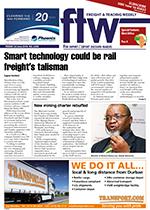Densification of key African cities over the next 10 to 15 years will necessitate the restructuring and hopeful re-emergence of Africa’s railways with the aid of information technology.
This is the view of Henning Seeschaaf, senior venture architect with German railways company Deutsche Bahn (DB).
Delivering a keynote address at the recent Africa Rail expo in Sandton, Seeschaaf said that freight in Germany had grown 40% in recent times, presenting the country’s transport infrastructure and freight companies with daunting challenges. As a result even DB, a company founded over 100 years ago, had to dig deep to remain relevant.
“Looking to another century of meeting the ever-changing and increasing demands of freight, DB took a conscious decision to transform itself from a railways company into a mobility provider,” Seeschaaf stated. This meant “building highly integrated systems that communicate with data and automatically update certain systems to enable smoother transportation”.
More importantly, it taught DB that a high state of technological readiness was required to meet the exponentially escalating demands of projected densification. In an African context the point is starkly driven home considering several World Bank predictions for 2030 – that Africa and Asia will attract 90% of global growth, that 60% of the world’s population will be living in urban environments, and that the current number of megacities will mushroom from 10 to 41.
As Johannesburg and Pretoria grow closer together and rampant urbanisation pushes Gauteng’s population to at least double the current number (12 million+), there’s no question that road freight will become vastly over-subscribed. Developing methodologies to steadily shift the current freight load from road to rail was the only answer, Seeschaaf said.
Underscoring his point, he stressed that it was not a matter of remaining relevant, as had been the case with DB, but restructuring railways across the continent by using “smart solutions to bring goods to the markets of growing cities”.
Seeschaaf said that since DB had been launched as a result of the age of steam, it meant “we’re really a start-up from the 1st industrial revolution”. It is with this mind-set that the company identified three key areas requiring immediate research and development.
Firstly, DB had to improve its own processes through the use of automated data transference, a primary feature of the so-called Internet of Things (IoT), thereby reducing downtime through predictive maintenance. In addition to implementing innovative technologies, the company also increased the capacity of infrastructure, scoping future infrastructural needs against a backdrop of identifying possible problems.
Lastly, DB worked towards establishing “flexible, integrated IoT systems that talk to one another in such a way that it makes for more fluid and progressive service delivery”.
Having made a strong case for the role that rail played in meeting Germany’s growing freight industry, Seeschaaf’s presentation underscored the argument that shifting bulk transportation from road to rail across Africa was no longer a question of if, but when.
INSERT AND CAPTION
Africa will have to find smart solutions to bring goods to the markets of growing cities. – Henning Seeschaaf

